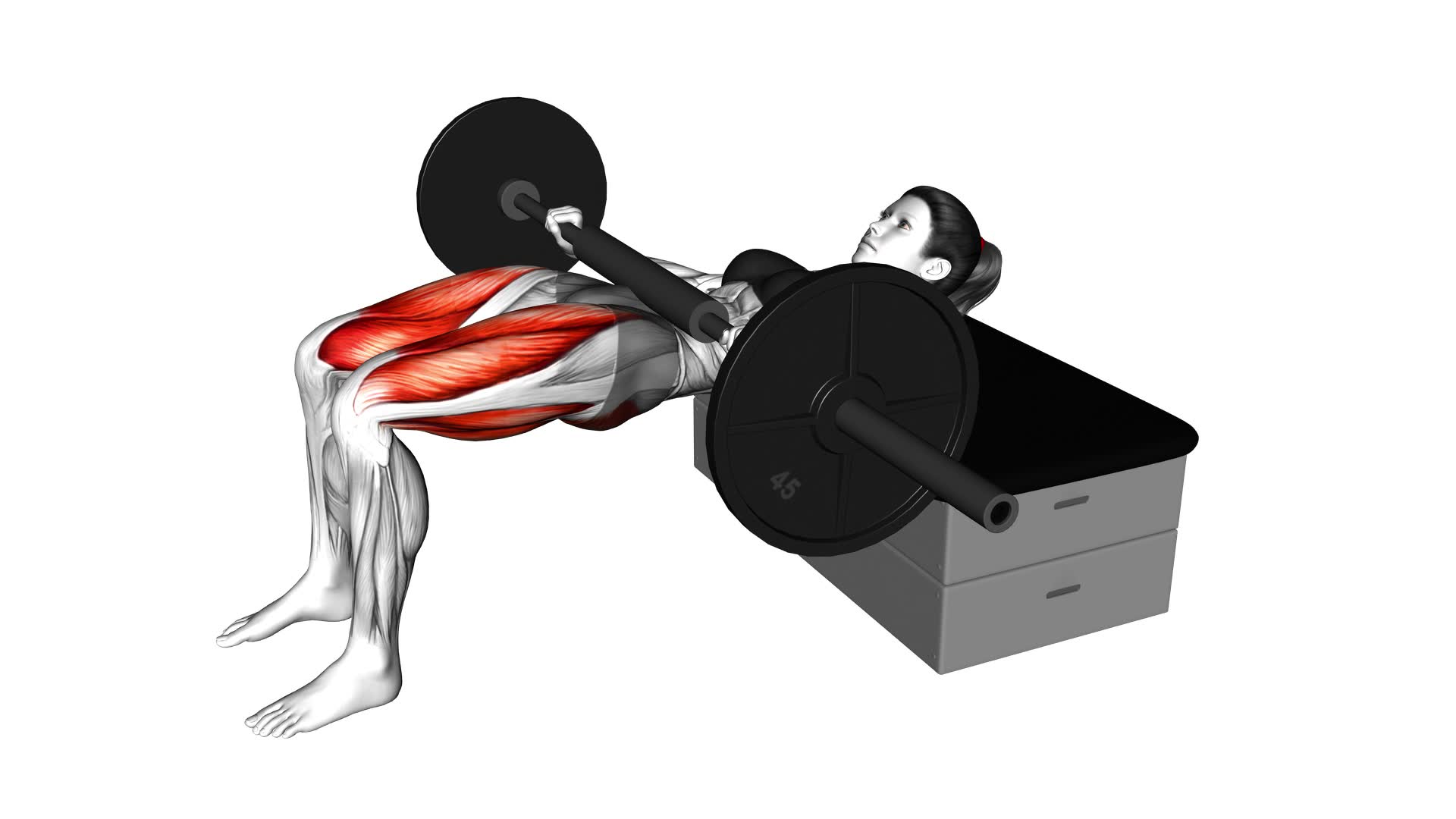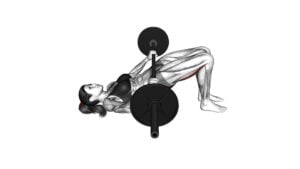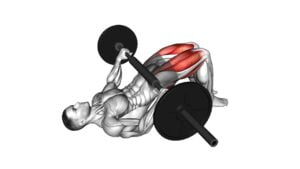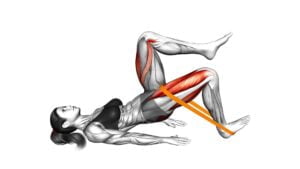Barbell KAS Glute Bridge (female) – Video Exercise Guide & Tips

Are you looking to strengthen your glutes and build a stronger posterior chain? Look no further than the Barbell KAS Glute Bridge.
Watch This Exercise Video
This exercise is a great way to target and activate your glute muscles, helping you improve your overall lower body strength and stability.
With the help of this video exercise guide and some helpful tips, you'll be able to perform this exercise with proper form and technique.
Get ready to feel the burn and see results!
Key Takeaways
- The Barbell KAS Glute Bridge targets and activates the glute muscles.
- It improves lower body strength, stability, and hip mobility.
- The exercise can alleviate lower back pain and strengthen and tone the gluteal muscles.
- Proper form and technique, such as maintaining alignment and engaging core muscles, are important for maximizing the benefits of the exercise.
Benefits of the Barbell KAS Glute Bridge
You can experience several benefits by incorporating the Barbell KAS Glute Bridge into your fitness routine. This exercise targets your gluteal muscles, specifically the gluteus maximus, medius, and minimus. By performing variations of the Barbell KAS Glute Bridge, you can further enhance the benefits of this exercise.
One of the main benefits of the Barbell KAS Glute Bridge is its ability to strengthen and tone your gluteal muscles. This exercise engages these muscles fully, helping to build strength and improve their appearance. Additionally, the gluteus maximus is the largest muscle in the body, so strengthening it can have positive effects on your overall strength and stability.
The Barbell KAS Glute Bridge also helps to improve your hip mobility and flexibility. By performing this exercise regularly, you can increase the range of motion in your hips, which can be beneficial for activities like running, squatting, and jumping.
Furthermore, the Barbell KAS Glute Bridge can also help to alleviate lower back pain. By strengthening your gluteal muscles, you can provide better support to your lower back, reducing the strain and discomfort often associated with this area.
Incorporating the Barbell KAS Glute Bridge into your fitness routine can provide numerous benefits, including stronger and more toned gluteal muscles, improved hip mobility, and reduced lower back pain. Make sure to try different variations of this exercise to maximize its benefits and challenge your muscles in different ways.
Equipment Needed for the Exercise
To perform the Barbell KAS Glute Bridge, you'll need essential exercise equipment such as a barbell and weights. The barbell will provide the resistance necessary to engage your glutes effectively.
If you don't have access to a barbell, you can consider using alternatives like dumbbells or resistance bands to achieve a similar effect.
Essential Exercise Equipment
To perform the Barbell KAS Glute Bridge exercise, you'll need the following essential exercise equipment:
- Barbell: The barbell is the main piece of exercise equipment needed for this exercise. It's used to add resistance and target the glute muscles effectively.
- Weight plates: You'll also need weight plates to load onto the barbell. The amount of weight you choose will depend on your fitness level and goals.
- Bench: A sturdy bench is essential for this exercise as it provides a stable surface for you to lie on and perform the glute bridge movement.
These three items of exercise equipment are necessary to perform the Barbell KAS Glute Bridge effectively and safely.
Now, let's discuss some alternate equipment options for those who mightn't have access to these specific items.
Alternate Equipment Options?
If you don't have access to the essential exercise equipment mentioned earlier, there are alternative options you can consider for performing the Barbell KAS Glute Bridge exercise.
Instead of using a barbell, you can use dumbbells or kettlebells to add resistance. Simply hold the weights in your hands and position them on your hips as you perform the exercise.
Another option is to use a resistance band. Loop the band around your thighs or knees and perform the glute bridge movement while maintaining tension on the band.
These substitution suggestions allow you to still target your glutes effectively without the need for a barbell.
Now, let's move on to discussing the proper form and technique for the exercise.
Proper Form and Technique for the Exercise
Start by positioning yourself on the ground with your back against a bench and your feet planted firmly on the floor. This exercise requires proper form and technique to ensure maximum effectiveness and avoid injury. Here are some tips for beginners and common mistakes to watch out for:
- Maintain proper alignment: Keep your head, shoulders, and upper back in contact with the bench throughout the entire movement. Avoid arching your back or lifting your hips too high.
- Engage your core: Before lifting your hips, activate your core muscles by drawing your belly button towards your spine. This will help stabilize your body and protect your lower back.
- Squeeze your glutes: As you lift your hips, focus on squeezing your glutes at the top of the movement. This will ensure that you're effectively targeting the glute muscles.
Transitioning into the subsequent section about variations and modifications of the barbell KAS glute bridge, it's important to first master the basic form and technique. Once you feel comfortable with the exercise, you can explore different ways to challenge yourself and progress further.
Variations and Modifications of the Barbell KAS Glute Bridge
Now let's explore some variations and modifications of the Barbell KAS Glute Bridge.
If you don't have access to a barbell, you can use dumbbells instead for added resistance.
Another option is to incorporate resistance bands to make the exercise more challenging.
Lastly, beginners can start with single-leg variations to build strength and stability gradually.
These modifications allow you to customize the exercise to your fitness level and equipment availability.
Dumbbell Alternatives for Glute Bridge
To perform the dumbbell alternatives for the glute bridge, grab a pair of dumbbells and position yourself on the floor.
Here are three variations you can try:
- Dumbbell Glute Bridge: Lie on your back with your knees bent and feet flat on the floor. Hold the dumbbells on your hips and lift your hips off the ground, squeezing your glutes at the top. Lower back down and repeat.
- Single-leg Dumbbell Glute Bridge: Similar to the previous variation, but this time, lift one leg off the ground while performing the glute bridge. This adds an extra challenge and targets each glute individually.
- Dumbbell Hip Thrust: Sit on the floor with your back against a bench and place the dumbbells on your hips. Bend your knees and plant your feet on the ground. Lift your hips up, driving through your heels, until your body forms a straight line from your knees to your shoulders. Lower back down and repeat.
These dumbbell variations provide an effective alternative to the barbell KAS glute bridge, allowing you to target your glutes in different ways and add variety to your workout routine.
Resistance Band Modifications
You can modify the barbell KAS glute bridge by incorporating resistance bands for added challenge and variation. Resistance bands offer several benefits for your glute bridge exercise routine.
They provide constant tension throughout the movement, forcing your glutes to work harder. This can lead to increased muscle activation and improved strength gains. Resistance bands also target the smaller stabilizer muscles in your hips, helping to improve overall stability and balance.
There are several resistance band exercises you can incorporate into your glute bridge routine. One option is to place the resistance band just above your knees and perform the glute bridge as usual. This adds an extra challenge by requiring you to push against the resistance of the band.
Another option is to place the band around your thighs and perform a lateral walk, taking small steps to the side while maintaining the glute bridge position. This exercise targets the gluteus medius, a muscle responsible for hip stability.
Single-Leg Variations for Beginners
When starting out with the barbell KAS glute bridge, beginners can incorporate single-leg variations to challenge themselves and make modifications to the exercise.
Here are three single leg progressions that can help activate your glutes and increase the difficulty of the exercise:
- Single-Leg Glute Bridge: Lift one leg off the ground and perform the glute bridge using only the other leg. This variation targets each glute individually, helping to improve balance and stability.
- Single-Leg Hip Thrust: Similar to the single-leg glute bridge, this variation requires you to lift one leg off the ground while performing the hip thrust. It further challenges the glutes and activates the core muscles.
- Pistol Squat Glute Bridge: Start in a seated position with one leg extended straight in front of you. Push through your heel and lift your hips off the ground, engaging your glutes. This variation combines glute activation with lower body strength.
By incorporating these single-leg variations, you can progress and customize your barbell KAS glute bridge routine.
Now, let's move on to some tips for getting the most out of the exercise.
Tips for Getting the Most Out of the Exercise
Maximize your results by focusing on proper form and engaging your glutes throughout the entire movement. To get the most out of the Barbell KAS Glute Bridge exercise, it's important to understand some common misconceptions and implement the following tips.
Firstly, it's crucial to maintain a neutral spine throughout the exercise. Avoid arching your back excessively or tucking your pelvis under. This will ensure that your glutes are properly activated and that the exercise targets the intended muscles effectively.
Additionally, make sure to keep your knees aligned with your toes and avoid letting them collapse inwards. This will help maintain stability and prevent any unnecessary strain on your knees.
Another tip is to focus on squeezing your glutes at the top of the movement. This will help to maximize the activation of your glute muscles and make the exercise more effective.
Lastly, it's important to control the movement throughout the entire range of motion. Avoid rushing through the exercise and instead, focus on maintaining a slow and controlled tempo.
By following these tips, you can ensure that you're getting the most out of the Barbell KAS Glute Bridge exercise.
Now, let's discuss some common mistakes to avoid while performing the exercise.
Common Mistakes to Avoid While Performing the Exercise
To avoid compromising the effectiveness of the exercise, it's important to focus on maintaining proper form and avoiding these common mistakes while performing the Barbell KAS Glute Bridge:
- Lifting the hips too high: One common mistake is lifting the hips excessively high, which can lead to hyperextension of the lower back. To maintain proper form, aim to achieve a straight line from the knees to the shoulders, without over-arching the back.
- Not engaging the glutes: Many people make the mistake of relying solely on their lower back muscles instead of engaging their glutes. To ensure proper activation of the glutes, squeeze them tightly at the top of the movement and focus on using them to lift the hips.
- Allowing the knees to cave in: Allowing the knees to collapse inward is another common mistake. This puts unnecessary stress on the knees and reduces the effectiveness of the exercise. To correct this, focus on pushing the knees outwards and maintaining proper alignment throughout the movement.
Frequently Asked Questions
How Many Repetitions and Sets Should I Do When Performing the Barbell KAS Glute Bridge?
When performing the barbell KAS glute bridge, it's important to consider the repetition and set range that suits you best. The number of repetitions and sets can vary depending on your fitness level and goals.
Start with a moderate range, such as 8-12 repetitions for 2-3 sets, and adjust as needed. Remember, there are variations and modifications you can explore to challenge yourself or accommodate any limitations you may have.
Can Men Also Benefit From Doing the Barbell KAS Glute Bridge Exercise?
Yes, men can definitely benefit from doing the barbell KAS glute bridge exercise. It helps to strengthen the glute muscles, improve hip stability, and increase overall lower body strength.
Men can also try different variations of the exercise, such as using heavier weights or incorporating resistance bands, to challenge themselves further.
Is It Safe to Perform the Barbell KAS Glute Bridge if I Have a History of Lower Back Pain?
If you have a history of lower back pain, it's important to prioritize your safety when performing the barbell KAS glute bridge. Consult with a healthcare professional or a qualified fitness trainer to determine if it's safe for you.
They can provide modifications or alternative exercises that are suitable for your condition. Remember, it's crucial to listen to your body and avoid any exercises that exacerbate your lower back pain.
Can the Barbell KAS Glute Bridge Help Improve My Running Performance?
The barbell KAS glute bridge can be a beneficial exercise for improving your running performance.
By targeting the glutes, it helps to strengthen these muscles which play a crucial role in running. Stronger glutes can enhance your power and endurance, allowing you to run faster and longer.
Additionally, this exercise can also help prevent injuries by improving stability and reducing stress on the lower back and knees.
Are There Any Specific Breathing Techniques I Should Follow While Doing the Barbell KAS Glute Bridge Exercise?
When doing the barbell KAS glute bridge, it's important to follow specific breathing techniques. Proper breathing can help you engage your core muscles and maintain stability throughout the exercise.
Take a deep breath in as you lower the barbell towards your hips, and exhale as you push your hips up towards the ceiling.
This controlled breathing pattern will enhance your performance and maximize the benefits of the exercise, regardless of gender.
Conclusion
In conclusion, the Barbell KAS Glute Bridge is a beneficial exercise that targets the glute muscles. It requires minimal equipment, making it accessible for anyone to try. By following proper form and technique, individuals can maximize the effectiveness of the exercise.
Additionally, there are variations and modifications available to suit different fitness levels. Remember to incorporate these tips and avoid common mistakes to get the most out of your workout.
Give the Barbell KAS Glute Bridge a try and feel the burn in your glutes!

Author
Years ago, the spark of my life’s passion ignited in my mind the moment I stepped into the local gym for the first time. The inaugural bead of perspiration, the initial endeavor, the very first surge of endorphins, and a sense of pride that washed over me post-workout marked the beginning of my deep-seated interest in strength sports, fitness, and sports nutrition. This very curiosity blossomed rapidly into a profound fascination, propelling me to earn a Master’s degree in Physical Education from the Academy of Physical Education in Krakow, followed by a Sports Manager diploma from the Jagiellonian University. My journey of growth led me to gain more specialized qualifications, such as being a certified personal trainer with a focus on sports dietetics, a lifeguard, and an instructor for wellness and corrective gymnastics. Theoretical knowledge paired seamlessly with practical experience, reinforcing my belief that the transformation of individuals under my guidance was also a reflection of my personal growth. This belief holds true even today. Each day, I strive to push the boundaries and explore new realms. These realms gently elevate me to greater heights. The unique combination of passion for my field and the continuous quest for growth fuels my drive to break new ground.







